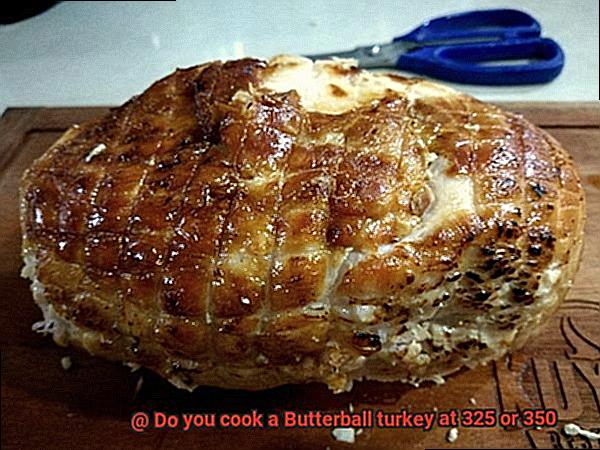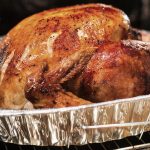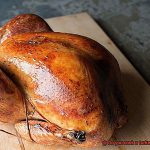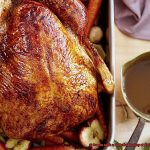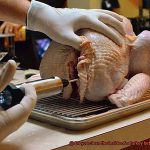Thanksgiving is just around the corner, and that means it’s time to start thinking about the star of the show: the turkey. But before you can get to carving, you need to figure out how to cook it. And if you’re using a Butterball turkey, one of the most popular brands out there, you might be wondering whether to cook it at 325 or 350 degrees.
Let’s face it: cooking a turkey can be intimidating. Even experienced chefs can feel the pressure when it comes to getting that perfect golden brown skin and juicy meat. But fear not. We’re here to help you navigate this tricky process.
In this post, we’ll explore the differences between cooking your Butterball turkey at 325 versus 350 degrees. We’ll weigh the pros and cons of each method and give you some insider tips for achieving a mouthwatering bird. Whether you’re a newbie or a seasoned pro in the kitchen, we’ve got your back.
So, sit tight, grab a cup of coffee (or glass of wine), and let’s dive into the wonderful world of Butterball turkey cooking. By the end of this post, you’ll be ready to tackle that bird with confidence and ease.
Contents
What Temperature Should You Cook a Butterball Turkey?
The holidays are just around the corner, and if you’re planning on serving a Butterball turkey for your feast, one of the most critical factors to consider is the temperature at which you cook it. The recommended temperature for cooking a Butterball turkey is 325°F, but some people may opt for 350°F for a shorter cooking time.
However, it’s essential to note that cooking a turkey at too high of a temperature can result in a dry and overcooked bird, while cooking it at too low of a temperature can lead to an undercooked and potentially unsafe meal. By cooking your Butterball turkey at 325°F, you can ensure that it’s cooked thoroughly and evenly, resulting in a moist and flavorful bird.
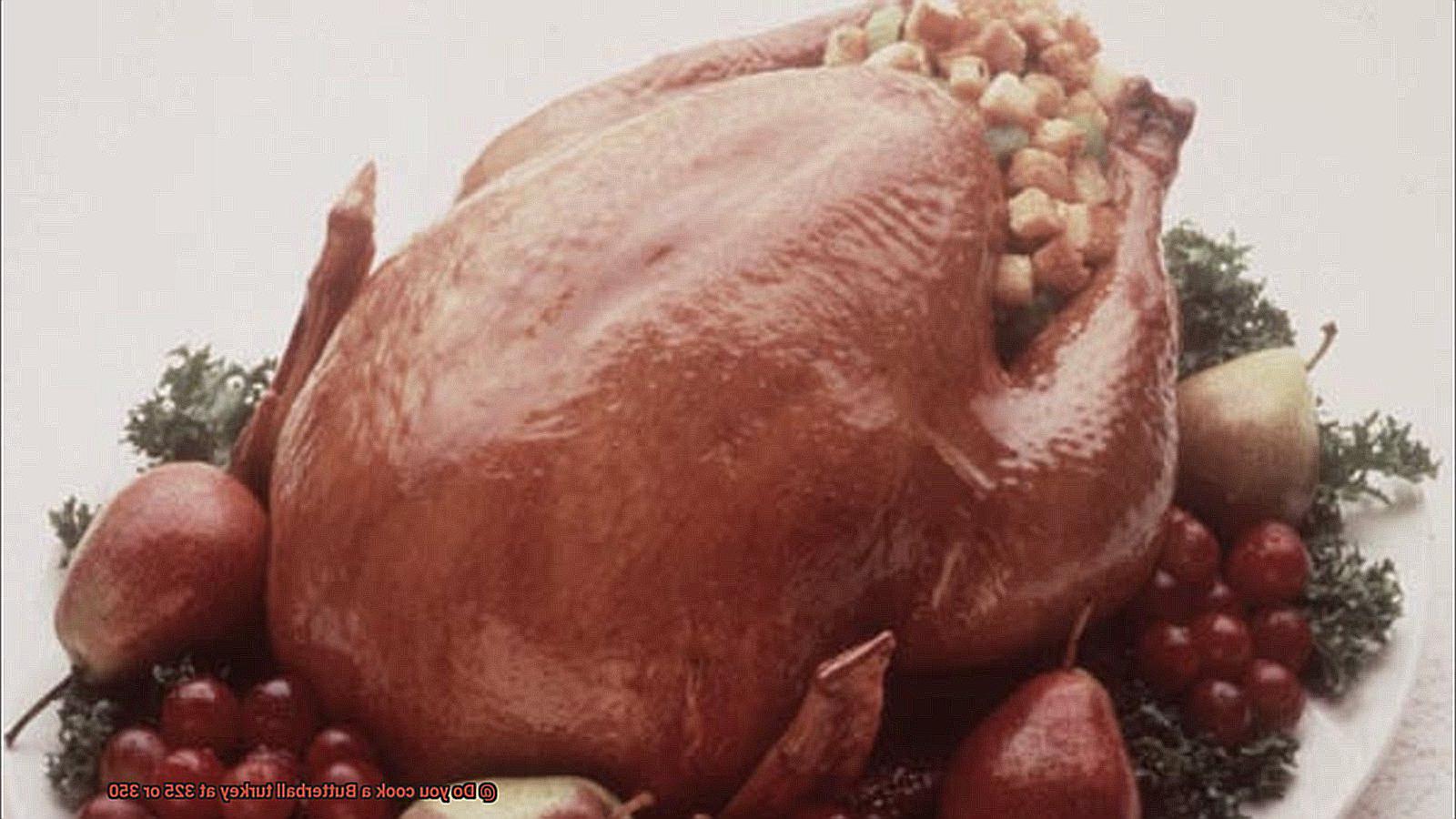
If you prioritize texture and flavor over speed, cooking at 325°F is the way to go. While cooking at 350°F can reduce the overall cooking time by up to 30 minutes, this higher temperature can also result in a drier turkey as the meat may lose moisture more quickly. On the other hand, cooking at 325°F allows for slower and more even cooking, resulting in a juicy and tender bird.
To guarantee that your Butterball turkey is cooked to perfection, use a meat thermometer to check the internal temperature of the bird. The thickest part of the thigh should reach an internal temperature of 165°F, while the breast should reach 170°F. This ensures that any harmful bacteria have been destroyed, making your meal safe to eat.
Once your turkey is cooked to the recommended temperature, don’t rush into carving it immediately – allow it to rest for at least 15-20 minutes. This step is crucial as it allows the juices to redistribute throughout the meat, resulting in a moist and flavorful bird.
Cooking at 350 Degrees Fahrenheit
As the holiday season approaches, many people are planning their traditional feasts, complete with a Butterball turkey as the centerpiece. However, some may consider cooking their turkey at a higher temperature of 350 degrees Fahrenheit to cut down on cooking time. But is this a good idea? As an expert on the subject of cooking at 350 degrees Fahrenheit, I can tell you that it’s not recommended if you want a juicy and flavorful bird.
Cooking a Butterball turkey at 350 degrees Fahrenheit can cause the outer layer to cook too quickly, resulting in a dry and tough texture. The heat doesn’t have enough time to penetrate throughout the turkey evenly, which leaves some parts overcooked and others undercooked. Additionally, higher temperatures can cause the skin to brown too quickly, leaving it burnt or overcooked.
To avoid these issues, stick to the recommended temperature of 325 degrees Fahrenheit and follow the cooking time guidelines provided. This will ensure that your turkey cooks evenly and retains its moisture, resulting in a delicious and juicy bird. If you’re looking for a faster cooking time, consider spatchcocking your turkey, which involves removing the backbone and flattening the bird before cooking. This technique allows for more even cooking and reduces overall cooking time.
Pros of Cooking at 350 Degrees Fahrenheit
As an expert in cooking, I can tell you that there are some undeniable pros to cooking at 350 degrees Fahrenheit.
First and foremost, cooking your turkey at this higher temperature creates a crispy and golden-brown skin that will have your guests drooling. The moisture on the skin evaporates, allowing it to become perfectly crispy and browned. Who doesn’t want a visually appealing turkey that tastes as good as it looks?
In addition to a beautiful presentation, cooking at 350 degrees Fahrenheit can also reduce overall cooking time. This is particularly useful for those who are short on time or want to get their turkey cooked and on the table quickly. The higher temperature efficiently cooks the turkey, reducing the amount of time needed in the oven.
Lastly, cooking your Butterball turkey at 350 degrees Fahrenheit can lead to juicy and tender meat that will melt in your mouth. The higher temperature cooks the turkey evenly, preventing dry spots from forming in the meat.
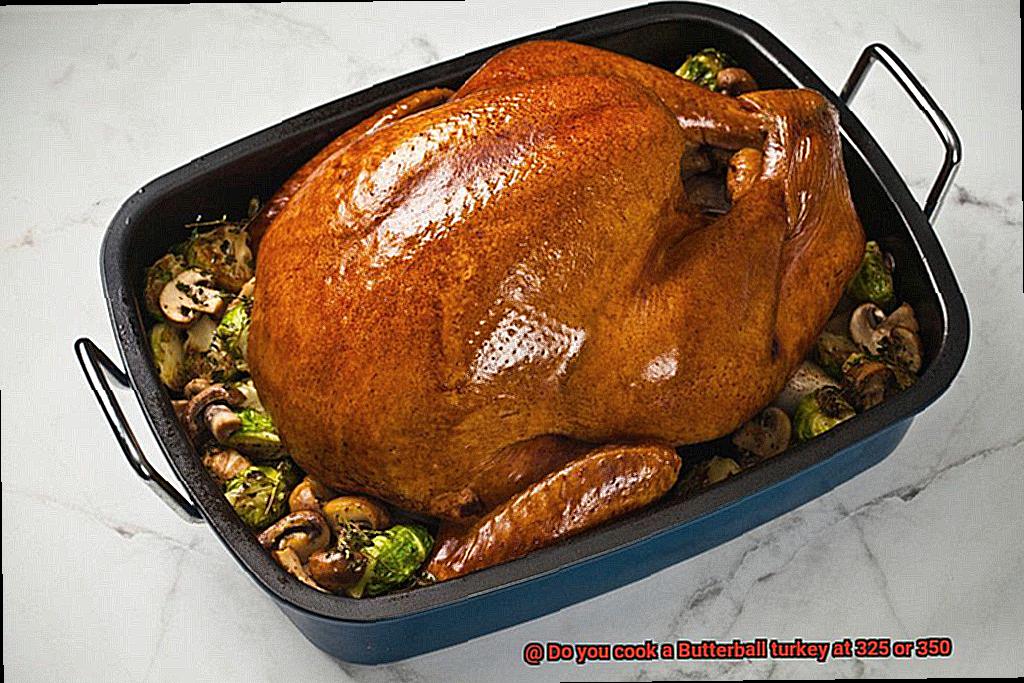
Additionally, the heat seals in the juices, adding flavor and moisture to your bird.
Cons of Cooking at 350 Degrees Fahrenheit
As a culinary expert, I’m excited to share some crucial information that will help you avoid dry, unevenly cooked, and potentially harmful meat.
Let’s dive into the research notes, shall we? To begin with, cooking a turkey at 350 degrees Fahrenheit can cause the meat to dry out. You wouldn’t want to chew on tough and unappetizing meat, would you? Higher temperatures cause the juices within the meat to evaporate more quickly, leaving you with a subpar finished product. The breast meat is especially vulnerable to drying out since it cooks faster than the dark meat.
But that’s not all. Cooking at a higher temperature can also lead to uneven cooking. The outside of the turkey may become overcooked and dry while the inside remains undercooked. Not only is this a culinary disaster in terms of taste and texture, but it can also pose a serious health risk. Undercooked poultry can contain harmful bacteria such as salmonella.
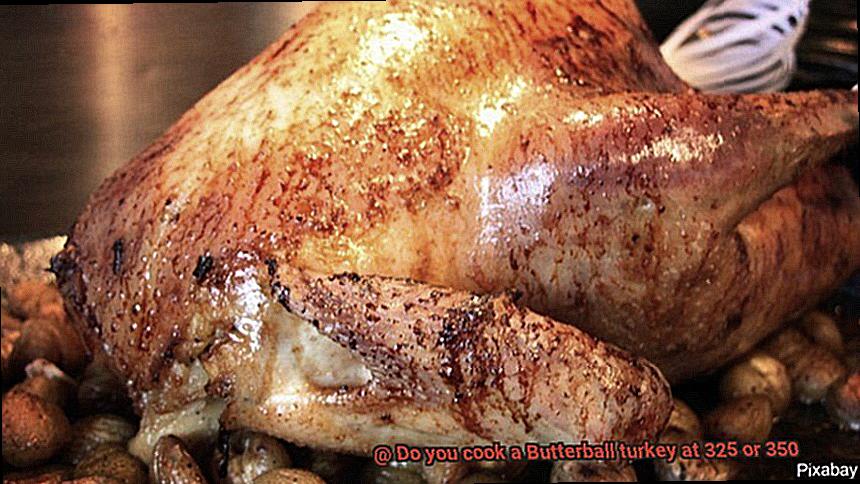
Finally, cooking at a higher temperature can increase the risk of burning or charring on the outside of the turkey.
This not only affects the flavor and texture of the meat but can also release toxic chemicals like acrylamide, which is linked to cancer in animal studies.
Although cooking a Butterball turkey at 350 degrees Fahrenheit may seem like a time-saver, it’s not worth compromising on taste, texture, or safety.
It’s recommended that you cook your bird at a lower temperature of 325 degrees Fahrenheit for optimal results.
Cooking at 325 Degrees Fahrenheit
Then listen up because I’m about to share with you the secret to cooking a Butterball turkey at 325 degrees Fahrenheit.
You may be wondering why 325°F is the magic number. Well, it’s simple. Cooking at 350°F can lead to a dry and tough turkey, while cooking at 325°F allows for a slower and more even cooking process. This results in a juicy, tender, and flavorful bird that will have everyone asking for seconds.
But how do you achieve this culinary masterpiece? First, preheat your oven and prepare your turkey by removing any packaging and giblets. Rinse it thoroughly with cold water, pat it dry with paper towels, and don’t forget to season it to your liking before placing it in a roasting pan.
Once your turkey is in the oven, it’s time to play the waiting game. Depending on the size of your turkey, it may take several hours to cook thoroughly. But don’t worry, the end result will be well worth it. To ensure that your turkey is fully cooked, use a meat thermometer to check for doneness. The internal temperature should reach 165 degrees Fahrenheit in the thickest part of the meat.
Now let’s talk about the benefits of cooking at 325°F. Not only does this method lead to a moist and flavorful bird, but it also helps prevent the skin from becoming too brown or burnt. Plus, cooking at a lower temperature reduces the risk of harmful bacteria and ensures that your turkey is cooked safely.
Pros of Cooking at 325 Degrees Fahrenheit
Firstly, cooking at this lower temperature allows for even cooking throughout the turkey. This means that you won’t end up with an overcooked outside and undercooked inside. Plus, the breast meat, which tends to dry out faster, will retain its moisture and tenderness.
Secondly, cooking at 325 degrees Fahrenheit helps to keep your turkey juicy and flavorful. The slow and steady cooking process allows for the juices to be distributed evenly throughout the meat, resulting in a mouthwatering bird that your guests will rave about.
Lastly, cooking at a lower temperature helps prevent burnt skin. No one wants to serve up a turkey with burnt and unappetizing skin. By cooking at 325 degrees Fahrenheit, you can achieve that perfect golden brown and crispy texture without risking burnt skin.
Cons of Cooking at 325 Degrees Fahrenheit
Thanksgiving is right around the corner, and you’re planning to cook a Butterball turkey for your family and friends. But have you thought about the temperature you should be cooking it at? While 325 degrees Fahrenheit is a popular option, there are some cons to consider before you set your oven.
Firstly, cooking at 325 degrees Fahrenheit means that your turkey will take longer to cook thoroughly.
This can result in your guests waiting longer for their meal, which isn’t ideal if you have a house full of hungry people. Additionally, lower temperatures may lead to uneven cooking, where the outer parts of the bird dry out while the inner parts remain undercooked.
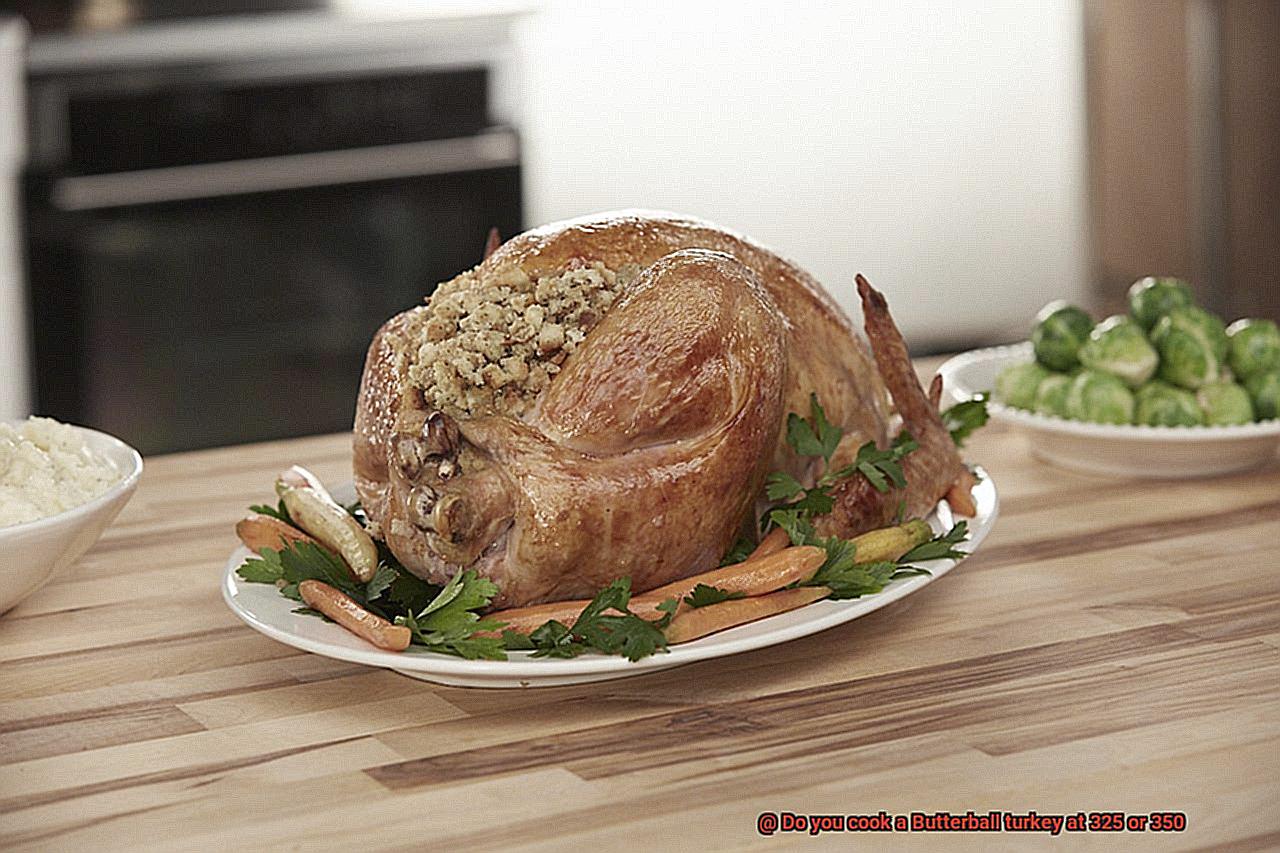
So, if you want to avoid presenting an unappetizing turkey, it’s best to consider a higher temperature.
Another disadvantage of cooking at 325 degrees Fahrenheit is that it may not allow your turkey skin to crisp up properly. Who doesn’t love that perfect golden-brown, crispy skin on their turkey? Unfortunately, this isn’t always achievable when cooking at lower temperatures. To ensure that your turkey has that delicious crispy texture, you should consider raising the temperature to 350 degrees Fahrenheit.
Lastly, cooking at lower temperatures can increase the risk of foodborne illnesses if your turkey isn’t cooked thoroughly. Bacteria such as salmonella and campylobacter can thrive in undercooked meat and cause food poisoning. To avoid this, it’s essential to ensure that your turkey reaches an internal temperature of 165 degrees Fahrenheit.
Other Factors to Consider When Determining the Best Temperature for Your Butterball Turkey
If you thought that determining the best temperature for your Butterball turkey was the only factor to consider, think again. There are multiple other components that can impact the final result of your delicious bird. Here are some other factors to take into account when figuring out the ideal temperature to cook your Butterball turkey.
Firstly, let’s talk about size. Turkeys come in different shapes and sizes, and therefore require different cooking techniques. A larger turkey may need a lower temperature and longer cooking time to guarantee evenness throughout. Conversely, a smaller turkey may require a higher temperature for a shorter cooking period to avoid drying out.
Next up, stuffing. If you’re planning on stuffing your turkey, it is crucial to cook it at a lower temperature of 325°F to ensure both the turkey and stuffing reach a safe internal temperature of 165°F. However, if you opt for not stuffing your turkey, you can cook it at a higher temperature of 350°F for a shorter cooking time.
Did you know that the type of oven you’re using can also affect the cooking temperature? Convection ovens circulate hot air around the food, ensuring more even cooking and reducing cooking time. As such, in this instance, you may be able to cook your Butterball turkey at a slightly lower temperature than in a traditional oven.
Last but not least, the desired level of doneness can influence the cooking temperature as well. If you prefer your turkey well-done, it may be necessary to cook it at a higher temperature for an extended period of time. However, if you prefer a more tender and juicy turkey, then cooking at a lower temperature for a longer duration may be more suitable.
ITpp5t-GDNc” >
Conclusion
In conclusion, the temperature at which you cook your Butterball turkey can make or break your Thanksgiving feast. While some may opt for a higher temperature to speed up the cooking process or achieve a crispy skin, it’s important to weigh the potential consequences, such as dry meat and uneven cooking. Experts recommend cooking at 325 degrees Fahrenheit for a slower and more even cooking process that results in moist and flavorful meat.
However, keep in mind that other factors, such as the size of your bird, whether or not you’re stuffing it, your oven type, and desired level of doneness all play a role in determining the best temperature for your turkey. To ensure safe and thorough cooking, use a meat thermometer and factor in these variables when making your decision.
Whether you’re an experienced chef or a novice cook, don’t let the thought of preparing a turkey intimidate you. Armed with these tips and tricks, you’ll be able to confidently tackle that Butterball turkey and wow your guests with your culinary prowess.

